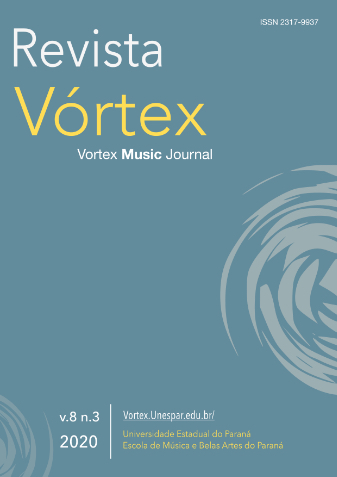Parsimonious relations between Guitar Textural Proposals
DOI:
https://doi.org/10.33871/23179937.2020.8.3.1.1Keywords:
Composition, Acoustic Guitar, Musical Texture, Musical Analysis, Leo BrouwerAbstract
Guitar Textural Analysis is an analytical proposal devised for the composition for the guitar that exposes the relations between the textural structure and the technical procedures used in the instrumental performance. The Guitar Textural Proposals (GTPs) are the specific configurations extracted in this analytical process. In the present work, the focus remains on recognizing parsimonious movements between GTPs, that is, minimal distinctions between patterns of use of the instrument combined with respective textural configurations. Parsimoniousness is defined in the context of Developing Variation, Neo-Riemannian Theory, and Partitional Analysis. Previous works by Fabio Adour and authors Sérgio Freire and Pedro Cambraia present perspectives on the relation between texture and guitar performance. Leo Brouwer's series of progressive pieces Études Simples is adopted as a reference. The work results in a proposal for a ordered network of technical-textural configurations connected by parsimonious relations.Downloads
References
ADLER, Samuel. The study of orchestration. Nova Iorque: W. W. Norton & Company, 2002.
ADOUR, Fábio. Sobre a Composição para o Violão. Dissertação (Mestrado em Música). Centro de Letras e Artes, Universidade Federal do Rio de Janeiro. Rio de Janeiro, 1999
ALMADA, Carlos de Lemos. Vector Representation of Triadic Transformations. Per Musi, Belo horizonte: UFMG. No. 38, p. 1-12, 2018.
ANDREWS, George. The Theory of Partitions. Cambridge: Cambridge University, 1984.
BERRY, Wallace. Structural Functions in Music. NewYork: Dover, 1976
BROUWER, Leo. Estudios Sencillos. Paris: Editions Max Eschig, 1972. Score. Guitar.
CARVALHO, Tiago Cabral. (2017). Por um modelo morfológico aplicado í análise musical: investigando processos criativos na Sinfonia em Quadrinhos de Hermeto Pascoal. Tese de Doutorado. João Pessoa: Universidade Federal da Paraíba.
COHN, Richard. Neo-Riemannian Operations, Parsimonious Trichords, and Their "Tonnetz" Representations. Journal of Music Theory, Vol. 41, No. 1, (Spring,), 1-66, 1997.
COHN, Richard. Introduction to Neo-Riemannian Theory: A Survey and a Historical Perspective. Journal of Music Theory, Vol. 42, No. 2, Neo-Riemannian Theory (Autumn, 1998), pp. 167-180.
COLLISON, Stephen. Grundgestalt, Developing Variation, and Motivic Processes in the Music of Arnold Schoenberg: An Analytical Study of the String Quartets. Thesis (PhD.). Londres: King"™s College, 1994.
DOUTHETT, Jack and STEINBACH, Peter. (1998). Parsimonious Graphs: A Study in Parsimony, Contextual Transformations, and Modes of Limited Transposition. Journal of Music Theory, n. 42, v. 2, p.241 - 263.
FRISCH, Walter. Brahms and the Principle of Developing Variation. Berkeley: University of California, 1984.
FREIRE, Sérgio; CAMBRAIA, P. Analysis of musical textures played on the guitar by means of real-time extraction of mid-level descriptors. 12th International Conference on Sound and Music Computing. Proceedings... Maynooth: Maynooth University, 2015. v. 1. p. 509-514.
GENTIL-NUNES, Pauxy. PARSEMAT - Parseme Toolbox Software Package. Rio de Janeiro: Pauxy Gentil-Nunes. 2004. Disponível em https://pauxy.net/parsemat-2/. Acesso em 01/11/2020.
_____. Parsemas e o método de Fux. Revista Pesquisa e Música. Rio de Janeiro: Conservatório Brasileiro de Música, 2006, v. 1, p. 38-47.
_____. Análise particional: uma mediação entre análise textural e a teoria das partições. 2009. Thesis (Doctor Degree, Music). Centro de Letras e Artes, Universidade Federal do Estado do Rio de Janeiro, Rio de Janeiro, 2009.
_____. Formalização do espaço textural melódico em instrumentos monofônicos. XXVI Congresso da ANPPOM. Proceedings"¦ Belo Horizonte: UFMG, 2016. Disponível em https://www.anppom.com.br/congressos/index.php/26anppom/bh2016/paper/download/4332/1373. Acesso em 02/11/2020.
_____. Análise Particional e Análise Textural: uma abordagem cognitiva do Particionamento rítmico. 13° Colóquio de Pesquisa do Programa de Pós-Graduação em Música da UFRJ. Proceedings"¦ Rio de Janeiro: UFRJ, 2014, p. 79–86. Disponível em https://ppgm.musica.ufrj.br/analise-particional-e-analise-textural-uma-abordagem-cognitiva-do-particionamento-ritmico/. Acesso em 31/10/2020.
_____. Partitiogram, mnet, vnet and tnet: Embedded abstractions inside compositional games. In: The Musical-Mathematical Mind: patterns and transformations. Berlin: Springer, 2017, p.111-118.
_____. Nesting and intersections between partitonal complexes. Musmat: Brazilian Journal of Music and Mathematics, vol. 2 #1, p. 93-108, 2018.
GENTIL-NUNES, Pauxy e RAMOS, Bernardo. Complexos Particionais. National Congress of Music and Mathematics of UFRJ. Proceedings...Rio de Janeiro: UFRJ, 2018.
GUIGUE, Didier. The Function of Orchestration in Serial Music: The Case of Webern"™s Variations Op. 30 and a Proposal of Theoretical Analysis. MusMat - Brazilian Journal of Music and Mathematics, 2018, v. 2, no. 1, pp. 114–138.
HAIMO, Ethan. Atonality, Analysis, and the Intentional Fallacy. Music Theory Spectrum. vol. 18, number 2, p. 167-199, 1996.
KOPP, David. Chromatic Transformations in Nineteenth-Century Music. New York: Cambridge University Press, 2002.
MORAES, Pedro Miguel. (2020). O corpo como fator de modelagem da textura pianística. III Congresso da Associação Brasileira de Teoria e Análise Musical (TeMA) & IV Congresso Internacional de Música e Matemática. Proceedings"¦ Rio de Janeiro: PPGM-UFRJ, 2020 (in press), pp. 1–26.
MOREIRA, Daniel. Contornos musicais e textura: perspectivas para análise e composição. IV SIMPOM. Proceedings"¦ Rio de Janeiro: UNIRIO, 2016.
MOREIRA, Daniel. Textural Design: a compositional theory for the organization of musical texture. Thesis (Doctor Degree, Music). Centro de Letras e Artes, Universidade Federal do Estado do Rio de Janeiro, Rio de Janeiro, 2019.
PISTON, Walter. Orchestration. London: Victor Gollancs LTD, 1969.
PITOMBEIRA, Liduino. Modelagem sistêmica como metodologia pré - composicional. XXVII Congresso da Associação Nacional de Pesquisa e Pós-Graduação em Música. Proceedings"¦ Campinas: UNICAMP, 2017, p. 1–19. Disponível em https://anppom.com.br/congressos/index.php/27anppom/cps2017/paper/viewFile/5096/1811. Acesso em 02/11/2020.
RAMOS, Bernardo. Análise de Textura Violonística: teoria e aplicação. 2017. Dissertation (Master Degree, Music). Universidade Federal de Rio de Janeiro. Rio de Janeiro, 2017.
RIMSKY-KORSAKOV, Nicolay. Principles of orchestration. New York: Dover Publications, 1964.
Downloads
Published
How to Cite
Issue
Section
License
Copyright (c) 2021 Bernardo Ramos Pinto, Pauxy Gentil-Nunes

This work is licensed under a Creative Commons Attribution 4.0 International License.
Autores mantêm os direitos autorais e concedem à revista o direito de primeira publicação, com o trabalho simultaneamente licenciado sob a Licença Creative Commons Attribution que permite o compartilhamento do trabalho com reconhecimento da autoria e publicação inicial nesta revista.






